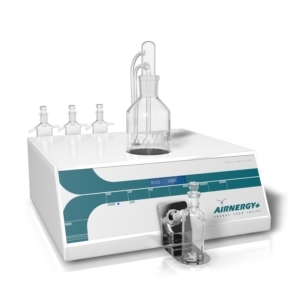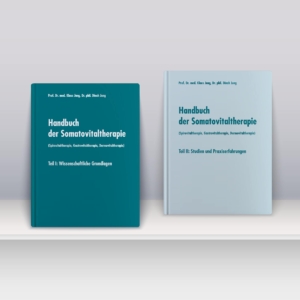Lung diseases – high-quality oils & COPD
COPD (Chronic Obstructive Pulmonary Disease) is a life-threatening lung disease – it affects about 14% of adult humanity.
COPD is a lung disease on the rise. It affects around 600 million people worldwide – and the number is rising. With somatovital therapy, COPD sufferers can alleviate their symptoms and experience a new quality of life through this therapy.
The effectiveness of high-quality oils is no longer in doubt. The odours of essential oils have a harmonizing, stimulating, calming effect and even lift the mood. They help to achieve a physical and mental well-being and relieve the most diverse ailments in a gentle way.

AIRNERGY & COPD Oil
Aromatherapy with COPD oil is also possible for patients with COPD disease. A natural 100% pure blend of eucalyptus, pine needle, peppermint and mint oils ideally offer additional use in the respective use by conventional inhalers or in the spirovital therapy of AIRNERGY by means of the aroma set. The active ingredients of the oil are sent directly to the desired location in the event of respiratory diseases.
Essential oil is still considered one of the best remedies against many ailments, especially when it comes to respiratory diseases.
For example, the eucalyptus oil is antiseptic, so it helps against pathogens and helps especially on the urinary tract and respiratory tract. It relieves cramps and phlegm and cleanses the blood. Furthermore, eucalyptus oil is ideal for asthma – whether it’s a cold, flu, bronchitis or angina. The concentration is also stimulated and the blood sugar level is lowered by the oil.
Pine sprouts have been shown to liquefy mucus on bronchial mucus; an important mechanism, because bronchial mucus contains the annoying pathogens and it also makes breathing much more difficult. The fact that the ingredients are absorbed directly from the airways during internal and external uptake (e.g. inhalation) and thus have a direct effect on the secretions of the bronchi, they can develop their effect at all. Thus, the mucus can also be coughed off more easily after liquefaction.
Peppermint oil has the pain-blocking effect of pain of muscles, nerves and headaches as well as itching. Peppermint oil stimulates the flickering hairs throughout the bronchial tree to increase activity, so that even stuck mucus can be coughed off.
The effects of COPD oil thus offer an ideal combination with AIRNERGY spirovital therapy. Let your bronchi breathe more easily.
Dr. Klaus Jung / Dr. phil. Dinah Jung (2014) Handbook on Somatovital Therapy Part II: Studies and Practical Experiences – Monsenstein and Vannerdat

Short description of the clinical picture
COPD is a progressive damage to the respiratory tract and lungs, leading to increasing mucousness and shortness of breath. Two manifestations are possible in varying degrees of severity, on the one hand chronic bronchitis (accompanied by inflammation and narrowing of the bronchi), on the other hand the emphysema (enlargement and damage of the alveoli). Chronic obstructive pulmonary disease is extremely widespread, affecting predominantly over 40-year-old smouldering and/or polluted men. Inheritance plays a lesser role. Symptoms can develop over years (morning coughing of tough mucus, increased mucus formation, coughing, frequent respiratory infections with formation of greenish-yellow mucus, shortness of breath, whistling inspiration). In order to quantify the extent of the injury, the measurement of FEV1 < (70%) paO2 ( < 60 mmHg). It is generally considered that damage caused by COPD with emphysema is largely irreversible, but the symptoms can be alleviated (inhalers, medications, long-term oxygen therapy, respiratory gymnastics, general roborization, flu vaccination). In principle, an improvement in the oxygen supply of all organ systems and an improvement of the immune situation (reduction of mucus formation, infection prophylaxis, formation of less tough mucus) are in the foreground of all therapeutic measures.
Effect of energized breathing air (spirovitalization)
All body cells depend on the constant supply of oxygen. The oxygen content of the inhaled air, the functional efficiency of the airways, the diffusion capacity for oxygen from the alveoli into the vascular system, the transport via an intact vascular system and numerically sufficient and functional erythrocytes, an orderly transition of oxygen from the capillaries into the tissue, a permeable interstitium, an intact uptake into the individual cells, further transport into numerically sufficient and functional mitochondria and an optimal enzyme capacity for aerobic metabolism all play a major role. Disruptions are conceivable in many places. In the case of pulmonary emphysema, the problem is primarily due to the insufficient diffusion capacity for oxygen from the alveoli into the vascular system. In chronic bronchitis, inflammation and narrowing are added to the laying of bronchioles or bronchi. The full image of COPD is characterized by the additional formation and the „non-coughing“ of tough mucus and increasing shortness of breath (oxygen distress). There is therefore no lack of oxygen in the breathing air, but the oxygen does not reach the target (mitochondria). Spirovitalisation reduces this deficit or at least partially eliminates the problem. By a short-term activation of the inhalation air before entering the respiratory tract, the initself sluggish molecular oxygen of the ambient air is activated (by formation of singlet oxygen, a stimulated but not radicalized form). This active state lasts only a fraction of a second. Even before the air is inhaled, the activated oxygen falls back to its original (ground) state. In this process, the previously absorbed energy is released again and released to the surrounding water, through which the breathing air is passed. With the inhalation of atmospheric oxygen, the airways are also fed to the energized water as a result of the water vapour saturation of the inhaled air, which initiates the desired increase in oxygen utilization. Due to this water-mediated energy transfer, on the one hand, a multiplication of 2,3 diphosphoglyzerate (2,3DPG), an important vitalizer of the intermediate phosphate group compensation in the conversion of 3PG into 2PG, an important step of the anaerobalactatic energy production in the erythrocytes, occurs on the one hand. In general, the concentration of the 2.3DPG is low, by spirovitalization it is demonstrably significantly increased. This allows 3PG to be converted to 2PG faster, which accelerates the transition from 1.3DPG to 3PG with an increase in the formation of ATP at the same time, with the result that the oxygen binding curve shifts to the right. Thus, with the same O2 saturation of the pO2 is increased or remains the same with lower O2 saturation of the pO2. This means an increased oxygen release to the environment, synonymous with a possible improvement in the utilization of oxygen, which is also manifested in an increase in AVDO2. By this mechanism, the observation seems to explain that spirovitalization, despite less diffusion of oxygen from the alveoli into the vascular system, can contribute to a sufficient oxygen supply to the individual organ systems. A second important effect of spirovitalization is the increase in immune competence. This is caused on the one hand by an increased activity of the white blood count, a reduced readiness for inflammation and a decrease in oxidative stress. Furthermore, spirovitalization (singuletoxygen) has been shown to intercept reactive oxygen types (ROS) or to a reduction in O2 radical formation. Irreversible damage to amino acids in the human body caused by atmospheric nitrate radicals is considered by experts to be a potential cause of respiratory disease.
Case studies and studies
- COPD with pulmonary emphysema, paO2 approx. 50 mmHg, duration O2 therapy so far rejected due to relatively good subjective condition, partial improvement after acupuncture, skeptical attitude towards spirovitalization, beginning with 3 x 10 or later 3 x 15 min tgl., 3 x / where., despite unfavorable weather, significant improvement of the subjective condition, increase of the paO2 rather slightly to 54 mmHg, overall positive judgment.
- Clinic diagnosis: infectious COPD with pulmonary emphysema, increased formation of tough mucus that is hard to cough, nocturnal coughing fits, after spirovitalization (up to 1 x 21 min) easier coughing of much and more liquid mucus, freer breathing.
- COPD with pulmonary emphysema, 71 a, severe deterioration in recent years, recent increasing shortness of breath, specialist treatment, after cold (wet cold weather) severe setback, after spirovitalization immediate improvement (no more shortness of breath, walking and climbing stairs again possible).
- COPD since about 12 a, side effects due to drug therapy (stomach, eyes), already after the first Spirovital application significant subjective and objective improvement (well-being, activity, less medications especially prednisone reduction, no more exacecations, no more colds, significant increase in oxygen saturation).
- COPD due to smoking and occupational asbestos exposure, 55 a, lack of air, lack of energy, walking distance 25 m, to nothing more able to achieve a significant improvement (more air, more energy) just a few days after the start of spirovitalization, increase of paO2 from under 70 to over 90 mmHg, improvement of lung function, even 1 a later no relapse, overall significant improvement (in the work process, on the home trainer, in terms of physical performance).
- COPD, 66 a, since 5 a in specialist treatment, since spirovitalization no more colds, more energy, better subjective condition, increase in oxygen content in the blood, less coughing, easier walking.
- COPD, 59 a, after spirovitalization short-term deterioration of subjective condition, then „amazing“ improvement (climbing stairs without air shortage, raising energy levels, better sleep, no more fatigue).
- COPD, 78 a, strong smoker throughout life, before 4 a after pneumonia severe deterioration of subjective and objective condition (COPD), inhalation regulation, further deterioration to total immobility, after spirovitalization continuous increase of FEV1 from 0.59 l to 0.80 l and the FVC from 1.86 l to more than 3.10 l (increase by 210 and 1,150 ml respectively). There is a significant increase in subjective state and performance.
- COPD, 65 a, constant mucosa, additionally osteoporosis, rheumatoid arthritis, osteoarthritis; maximum walking distance approx. 200 m, lack of air, no appetite; Since Spirovitaluse reduction of inhaler applications, increase of peak flow (PEF) from 200 to 300 l/min, regular participation in lung sports without problems, more energy, more stamina, no more shortness of breath, improvement of blood circulation, easier coughing of more liquid mucus, improvement of sleep, more self-confidence, better condition.
Survey of end users and therapists
In 2007, the scientific evaluation of declining opinions of Spirovitalend users and spirovital therapists in recent years was carried out, an overall insightful analysis. In 42 minutes, 163 diseases or disorders were reported (3.9 data per protocol). 77 percent of the complaints reported covered functional areas and 23 percent for organic areas. There was no age dependency on success, with figures ranging from 21 to 91 years. Sometimes there was a temporary deterioration, at the latest from the 7th day of application, clear subjective, usually also objective improvements occurred in all cases.
End user
An evaluation of the end-user data on the effectiveness of spirovitalization in organic diseases showed that the device was also successfully used in respiratory diseases, detailed in bronchial asthma, sleep apnea, bronchitis, COPD and pulmonary emphysema. With regard to the functional disorders common in COPD, the end users had a positive assessment of spirovital therapy for energy status (performance, activity, resilience, strength, motivation), well-being (sleep quality, mood, breathing, digestion, pain, immune situation) and regeneration (deepening, acceleration, relaxation, pulse calming). The individual aspects applied to all end users, but the ranking was different depending on the individual starting position. There is therefore no doubt that many of the positive functional changes indicated also affected the clinical picture „COPD with pulmonary emphysema“.Therapists
The therapist’s assessment also revealed an effective use of spirovital therapy in respiratory diseases. Asthma and COPD were cited as special indications. According to the therapists, functional disorders associated with COPD and asthma can also be well influenced by spirovitalization, especially loss of performance, sleep disturbances and weakening of the immune system.

Short video: Why AIRNERGY for COPD?
Adresse
AIRNERGY Schweiz GmbH
Wartensee 2
9404 Rorschacherberg
Headquarter:
AIRNERGY International GmbH
Wehrstr. 24-26
D-53773 Hennef
Kontakt
Telefon: +49 (0) 22 42 - 93 30-0
Telefax: +49 (0) 22 42 - 93 30-30
E-Mail: info℘airnergy.ch
Export: export℘airnergy.com


